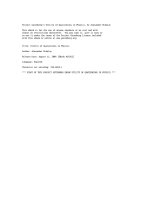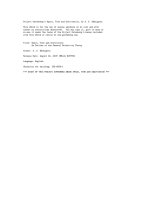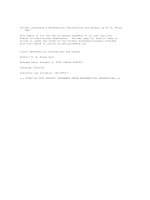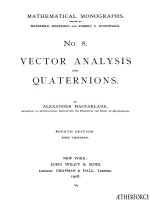Project Gutenberg’s Vector Analysis and Quaternions, by Alexander Macfarlane ppt
Bạn đang xem bản rút gọn của tài liệu. Xem và tải ngay bản đầy đủ của tài liệu tại đây (455.76 KB, 65 trang )
Project Gutenberg’s Vector Analysis and Quaternions, by Alexander Macfarlane
This eBook is for the use of anyone anywhere at no cost and with
almost no restrictions whatsoever. You may copy it, give it away or
re-use it under the terms of the Project Gutenberg License included
with this eBook or online at www.gutenberg.net
Title: Vector Analysis and Quaternions
Author: Alexander Macfarlane
Release Date: October 5, 2004 [EBook #13609]
Language: English
Character set encoding: TeX
*** START OF THIS PROJECT GUTENBERG EBOOK VECTOR ANALYSIS AND QUATERNIONS ***
Produced by David Starner, Joshua Hutchinson, John Hagerson, and the
Project Gutenberg On-line Distributed Proofreaders.
i
MATHEMATICAL MONOGRAPHS.
EDITED BY
MANSFIELD MERRIMAN and ROBERT S. WOODWARD.
No. 8.
VECTOR ANALYSIS
and
QUATERNIONS.
by
ALEXANDER MACFARLANE,
Secretary of International Association for Promoting the Study of Quaternions.
NEW YORK:
JOHN WILEY & SONS.
London: CHAPMAN & HALL, Limited.
1906.
Transcriber’s Notes: This material was originally published in a book by Merriman and Wood-
ward titled Higher Mathematics. I believe that some of the pag e number cross-references have
been retained from that presentation of this material.
I did my best to recreate the index.
ii
MATHEMATICAL MONOGRAPHS.
edited by
Mansfield Merriman and Robert S. Woodward.
Octavo. Cloth. $1.00 each.
No. 1. History of Modern Mathematics.
By David Eugen e Smith.
No. 2. Synthetic Projective Geometry.
By George Bruce Halsted.
No. 3. Determinants.
By Laenas Gifford Weld.
No. 4. Hyperbolic Functions.
By James McMahon.
No. 5. Harmonic Functions.
By William E. Byerly.
No. 6. Grassmann’s Space Analysis.
By Edward W. Hyde.
No. 7. Probability and Theory of Errors.
By Robert S. Woodward.
No. 8. Vector Analysis and Quaternions.
By Alexander Macfarlane.
No. 9. Differential Equations.
By William Woolsey Johnson.
No. 10. The Solution of Equations.
By Mansfield Merriman.
No. 11. Functions of a Complex Vari able.
By Thomas S. Fiske.
PUBLISHED BY
JOHN WILEY & SONS, I nc., NEW YORK.
CHAPMAN & HALL, Limited, LONDON.
Editors’ Preface
The volume called Higher Mathematics, the first edition of which was pub-
lished in 1896, contained eleven chapters by eleven authors, each chapter being
independent of the others, but all supposing the reader to have at least a math-
ematical training equivalent to that given in classical and engineering colleges.
The publication of that volume is now discontinued and the chapters are issued
in separate form. In these reissues it will generally be found that the mono-
graphs are enlarged by additional articles or appendices which either amplify
the former presentation or record recent advances. This plan of publication has
been arranged in order to meet the demand of teachers and the convenience
of classes, but it is also thought that it may prove advantageous to readers in
special lines of mathematical literature.
It is the intention of the publishers and editors to add other monographs to
the series from time to time, if the call for the same seems to warrant it. Among
the topics which are under consideration are those of elliptic functions, the the-
ory of numbers, the group theory, the calculus of variations, and non-Euclidean
geometry; possibly also monographs on branches of astronomy, mechanics, and
mathematical physics may be included. It is the hope of the editors that this
form of publication may tend to promote mathematical study and research over
a wider field than that which the former volume has occupied.
December, 1905.
iii
Author’s Preface
Since this Introduction to Vector Analysis and Quaternions was first published
in 1896, the study of the subject has become much more general; and whereas
some reviewers then regarded the analysis as a luxury, it is now recognized as a
necessity for the exact student of physics or engineering. In America, Professor
Hathaway has published a Primer of Quaternions (New York, 1896), and Dr.
Wilson has amplified and extended Professor Gibbs’ lectures on vector analysis
into a text-book for the use of students of mathematics and physics (New York,
1901). In Great Britain, Professor Henrici and Mr. Turner have published a
manual for students entitled Vectors and Rotors (London, 1903); Dr. Knott
has prepared a new edition of Kelland and Tait’s Introduction to Quaternions
(London, 1904); and Professor Joly has realized Hamilton’s idea of a Manual of
Quaternions (London, 1905). In Germany Dr. Bucherer has published Elemente
der Vektoranalysis (Leipzig, 1903) which has now reached a second edition.
Also the writings of the great masters have been rendered more accessible.
A new edition of Hamilton’s classic, the Elements of Quaternions, has been pre-
pared by Professor Joly (London, 1899, 1901); Tait’s Scientific Papers have been
reprinted in collected form (Cambridge, 1898, 1900); and a complete edition of
Grassmann’s mathematical and physical works has been edited by Friedrich En-
gel with the assistance of several of the eminent mathematicians of Germany
(Leipzig, 1894–). In the same interval many papers, pamphlets, and discussions
have appeared. For those who desire information on the literature of the subject
a Bibliography has been published by the Association for the promotion of the
study of Quaternions and Allied Mathematics (Dublin, 1904).
There is still much variety in the matter of notation, and the relation of
Vector Analysis to Quaternions is still the subject of discussion (see Journal of
the Deutsche Mathematiker-Vereinigung for 1904 and 1905).
Chatham, Ontario, Canada, December, 1905.
iv
Contents
Editors’ Preface iii
Author’s Preface iv
1 Introduction. 1
2 Addition of Coplanar Vectors. 3
3 Products of Coplanar Vect ors. 9
4 Coaxial Quaternions. 16
5 Addition of Vectors in Space. 21
6 Product of Two Vectors. 23
7 Product of Three Vectors. 28
8 Composition of Quantities. 32
9 Spherical Trigonometry. 37
10 Composition of Rotations. 44
Index 47
11 PROJECT GUTENBERG “SMALL PRINT”
v
Article 1
Introduction.
By “Vector Analysis” is meant a space analysis in which the vector is the funda-
mental idea; by “Quaternions” is meant a space-analysis in which the quaternion
is the fundamental idea. They are in truth complementary parts of one whole;
and in this chapter they will be treated as such, and developed so as to har-
monize with one another and with the Cartesian Analysis
1
. The subject to be
treated is the analysis of quantities in space, whether they are vector in nature,
or quaternion in nature, or of a still different nature, or are of such a kind that
they can be adequately represented by space quantities.
Every proposition about quantities in space ought to remain true when re-
stricted to a plane; just as propositions about quantities in a plane remain true
when restricted to a straight line. Hence in the following articles the ascent
to the algebra of space is made through the intermediate algebra of the plane.
Arts. 2–4 treat of the more restricted analysis, while Arts. 5–10 treat of the
general analysis.
This space analysis is a universal Cartesian analysis, in the same manner as
algebra is a universal arithmetic. By providing an explicit notation for directed
quantities, it enables their general properties to be investigated independently
of any particular system of coordinates, whether rectangular, cylindrical, or
polar. It also has this advantage that it can express the directed quantity by a
linear function of the coordinates, instead of in a roundabout way by means of
a quadratic function.
The different views of this extension of analysis which have been held by
independent writers are briefly indicated by the titles of their works:
• Argand, Essai sur une mani´ere de repr´esenter les quantit´es imaginaires dans les
constructions g´eom´etriques, 1806.
• Warren, Treatise on the geometrical representation of the square roots of nega-
tive quantities, 1828.
• Mo e bius, Der barycentrische Calcul, 1827.
• Bellavitis, Calcolo delle Equipollenze, 1835.
1
For a discussion of the relation of Vector Analysis to Quaternions, see Nature, 1891–1893.
1
ARTICLE 1. INTRODUCTION. 2
• Grassmann, Die lineale Ausdehnungslehre, 1844.
• De Morgan, Trigonometry and Double Algebra, 1849.
• O’Brien, Symbolic Forms derived from the conception of the translation of a
directed magnitude. Philosophical Transactions, 1851.
• Hamilton, Lectures on Quaternions, 1853, and Elements of Quaternions, 1866.
• Tait, Elementary Treatise on Quaternions, 1867.
• Hankel, Vorlesungen ¨uber die complexen Zahlen und ihre Functionen, 1867.
• Schlegel, System der Raumlehre, 1872.
• Ho ¨uel, Th´eorie des quantit´es complexes, 1874.
• Gibbs, Elements of Vector Analysis, 1881–4.
• Peano, Calcolo geometrico, 1888.
• Hyde, T he Directional Calculus, 1890.
• Heaviside, Vector Analysis, in “Reprint of Electrical Papers,” 1885–92.
• Macfarlane, Principles of the Algebra of Physics, 1891. Papers on Space Analy-
sis, 1891–3.
An excellent synopsis is given by Hagen in the second volume of his “Synopsis der
h¨oheren Mathematik.”
Article 2
Addition of Coplanar
Vectors.
By a “vector” is meant a quantity which has magnitude and direction. It is
graphically represented by a line whose length represents the magnitude on
some convenient scale, and whose direction coincides with or represents the
direction of the vector. Though a vector is represe nted by a line, its physical
dimensions may be different from that of a line. Examples are a linear velocity
which is of one dimension in length, a directed area which is of two dimensions
in length, an axis which is of no dimensions in length.
A vector will be denoted by a capital italic letter, as B,
1
its magnitude
by a small italic letter, as b, and its direction by a small Greek letter, as β.
For example, B = bβ, R = rρ. Sometimes it is necessary to introduce a dot
or a mark
to separate the specification of the direction from the expression
for the magnitude;
2
but in such simple expressions as the above, the difference
is sufficiently indicated by the difference of type. A system of three mutually
rectangular axes will b e indicated, as usual, by the letters i, j, k.
The analysis of a vector here supposed is that into magnitude and direction.
According to Hamilton and Tait and other writers on Quaternions, the vector
is analyzed into tensor and unit-vector, which means that the tensor is a mere
ratio destitute of dimensions, while the unit-vector is the physical magnitude.
But it will be found that the analysis into magnitude and direction is much
more in accord with physical ideas, and explains readily many things which are
difficult to explain by the other analysis.
A vector quantity may be such that its components have a common point
of application and are applied simultaneously; or it may be such that its com-
ponents are applied in succession, each component starting from the end of its
1
This notation is found convenient by electrical writers in order to harmonize with the
Hospitalier system of symbols and abbreviations.
2
The dot was used for this purpose in the author’s Note on Plane Algebra, 18 83; Kennelly
has since used
for the same purpose in his electrical papers.
3
ARTICLE 2. ADDITION OF COPLANAR VECTORS. 4
predecessor. An example of the former is found in two forces applied simul-
taneously at the same point, and an example of the latter in two rectilinear
displacements made in succession to one another.
Composition of Components having a com mon Point of Application.—Let
OA and OB represent two vec tors of the same kind simultaneously applied at
the point O. Draw BC parallel to OA, and AC parallel to OB, and join OC.
The diagonal OC represents in magnitude and direction and point of application
the resultant of OA and OB. This principle was discovered with reference to
force, but it applies to any vector quantity coming under the above conditions.
Take the direction of OA for the initial direction; the direction of any other
vector will be sufficiently denoted by the angle round which the initial direction
has to be turned in order to coincide with it. Thus OA may be denoted by f
1
/0,
OB by f
2
/θ
2
, OC by f/θ. From the geometry of the figure it follows that
f
2
= f
2
1
+ f
2
2
+ 2f
1
f
2
cos θ
2
and
tan θ =
f
2
sin θ
2
f
1
+ f
2
cos θ
2
;
hence
OC =
f
2
1
+ f
2
2
+ 2f
1
f
2
cos θ
2
tan
−1
f
2
sin θ
2
f
1
+ f
2
cos θ
2
.
Example.—Let the forces applied at a point be 2/0
◦
and 3/60
◦
. Then the
resultant is
4 + 9 + 12 ×
1
2
tan
−1
3
√
3
7
= 4.36/36
◦
30
.
If the first component is given as f
1
/θ
1
, then we have the more symmetrical
formula
OC =
f
2
1
+ f
2
2
+ 2f
1
f
2
cos(θ
2
− θ
1
)
tan
−1
f
1
sin θ
1
+ f
2
sin θ
2
f
1
cos θ
1
+ f
2
cos θ
2
.
When the components are equal, the direction of the resultant bisects the
angle formed by the vectors; and the magnitude of the resultant is twice the
projection of either component on the bisecting line. The above formula reduces
to
OC = 2f
1
cos
θ
2
2
θ
2
2
.
ARTICLE 2. ADDITION OF COPLANAR VECTORS. 5
Example.—The resultant of two equal alternating electromotive forces which
differ 120
◦
in phase is equal in magnitude to either and has a phase of 60
◦
.
Given a vector and one component, to find the other component.—Let OC
represent the resultant, and OA the component. Join AC and draw OB equal
and parallel to AC. The line OB represents the component required, for it is
the only line which combined with OA gives OC as resultant. The line OB is
identical with the diagonal of the parallelogram formed by OC and OA reversed;
hence the rule is, “Reverse the direction of the component, then compound it
with the given resultant to find the required component.” Let f /θ be the vector
and f
1
/0 one component; then the other comp onent is
f
2
/θ
2
=
f
2
+ f
2
1
− 2ff
1
cos θ
tan
−1
f sin θ
−f
1
+ f cos θ
Given the resultant and the directions of the two components, to find the
magnitude of the components.—The resultant is represented by OC, and the
directions by OX and OY . From C draw CA parallel to OY , and CB parallel
to OX; the lines OA and OB cut off represent the required components. It is
evident that OA and OB when compounded produce the given resultant OC,
and there is only one set of two components which produces a given resultant;
hence they are the only pair of components having the given directions.
Let f /θ be the vector and /θ
1
and /θ
2
the given directions. Then
f
1
+ f
2
cos(θ
2
− θ
1
) = f cos(θ − θ
1
),
f
1
cos(θ
2
− θ
1
) + f
2
= f cos(θ
2
− θ),
from which it follows that
f
1
= f
{cos(θ − θ
1
) −cos(θ
2
− θ) cos(θ
2
− θ
1
)}
1 −cos
2
(θ
2
− θ
1
)
.
ARTICLE 2. ADDITION OF COPLANAR VECTORS. 6
For e xample, let 100/60
◦
, /30
◦
, and /90
◦
be given; then
f
1
= 100
cos 30
◦
1 + cos 60
◦
.
Composition of any Number of Vectors applied at a c ommon Point.—The
resultant may be found by the following graphic construction: Take the vectors
in any order, as A, B, C. From the end of A draw B
equal and parallel
to B, and from the end of B
draw C
equal and parallel to C; the vector
from the beginning of A to the end of C
is the resultant of the given vectors.
This follows by continued application of the parallelogram construction. The
resultant obtained is the same, whatever the order; and as the order is arbitrary,
the area enclosed has no physical meaning.
The result may be obtained analytically as follows:
Given
f
1
/θ
1
+ f
2
/θ
2
+ f
3
/θ
3
+ ···+ f
n
/θ
n
.
Now
f
1
/θ
1
= f
1
cos θ
1
/0 + f
1
sin θ
1
π
2
.
Similarly
f
2
/θ
2
= f
2
cos θ
2
/0 + f
2
sin θ
2
π
2
.
and
f
n
/θ
n
= f
n
cos θ
n
/0 + f
n
sin θ
n
π
2
.
Hence
f/θ
=
f cos θ
/0 +
f
θ
π
2
=
f cos θ
2
+
f sin θ
2
· tan
−1
f sin θ
f cos θ
.
ARTICLE 2. ADDITION OF COPLANAR VECTORS. 7
In the case of a sum of simultaneous vectors applied at a common point,
the ordinary rule about the transposition of a term in an equation holds good.
For example, if A + B + C = 0, then A + B = −C, and A + C = −B, and
B +C = −A, etc. This is permissible because there is no real order of succession
among the given components.
3
Composition of Successive Vectors.—The composition of successive vectors
partakes more of the nature of multiplication than of addition. Let A be a
vector starting from the point O, and B a vector starting from the end of A.
Draw the third side OP , and from O draw a vector equal to B, and from its
extremity a vector equal to A. The line OP is not the complete equivalent
of A + B; if it were so, it would also be the complete equivalent of B + A.
But A + B and B + A determine different paths; and as they go oppositely
around, the areas they determine with OP have different signs. The diagonal
OP represents A + B only so far as it is considered independent of path. For
any number of successive vectors, the sum so far as it is independent of path is
the vector from the initial point of the first to the final point of the last. This is
also true when the successive vectors become so small as to form a continuous
curve. The area between the curve OP Q and the vector OQ depends on the
path, and has a physical meaning.
Prob. 1. The resultant vector is 123/45
◦
, and one component is 100/0
◦
; find the other
comp onent.
Prob. 2. The velocity of a body in a given plane is 200/75
◦
, and one component is
100/25
◦
; find the other component.
Prob. 3. Three alternating magnetomotive forces are of equal virtual value, but each pair
differs in phase by 120
◦
; find the resultant. (Ans. Ze ro.)
Prob. 4. Find the components of the vector 100/70
◦
in the directions 20
◦
and 100
◦
.
Prob. 5. Calculate the resultant vector of 1/10
◦
, 2/20
◦
, 3/30
◦
, 4/40
◦
.
Prob. 6. Compound the following magnetic fluxes: h sin nt + h sin(nt − 120
◦
)/120
◦
+
h sin(nt − 240
◦
)/240
◦
. (Ans.
3
2
h/nt.)
3
This does not hold true of a sum of vectors having a real order of succession. It is a
mistake to attempt to found space-analysis upon arbitrary formal laws; the fundamental rules
must be made to express universal properties of the thing denoted. In this chapter no attempt
is made to apply formal laws to directed quantities. What is attempte d is an analysis of these
quantities.
ARTICLE 2. ADDITION OF COPLANAR VECTORS. 8
Prob. 7. Compound two alternating magnetic fluxes at a point a cos nt/0 and a sin nt/
π
2
.
(Ans. a/nt.)
Prob. 8. Find the resultant of two simple alternating electromotive forces 100/20
◦
and
50/75
◦
.
Prob. 9. Prove that a uniform circular motion is obtained by compounding two equal
simple harmonic motions which have the space-phase of their angular positions
equal to the supplement of the time-phase of their motions.
Article 3
Products of Coplanar
Vectors.
When all the vectors considered are confined to a common plane, each may
be expressed as the sum of two rectangular components. Let i and j denote
two directions in the plane at right angles to one another; then A = a
1
i + a
2
j,
B = b
1
i + b
2
j, R = xi + yj. He re i and j are not unit-vectors, but rather signs
of direction.
Product of two Vectors.—Let A = a
1
i + a
2
j and B = b
1
i + b
2
j be any
two vectors, not necessarily of the same kind physically. We assume that their
product is obtained by applying the distributive law, but we do not assume that
the order of the factors is indifferent. Hence
AB = (a
1
i + a
2
j)(b
1
i + b
2
j) = a
1
b
1
ii + a
2
b
2
jj + a
1
b
2
ij + a
2
b
2
ji.
If we assume, as suggested by ordinary algebra, that the square of a sign of
direction is +, and further that the product of two directions at right angles to
one another is the direction normal to both, then the above reduces to
AB = a
1
b
1
+ a
2
b
2
+ (a
1
b
2
− a
2
b
1
)k.
Thus the complete product breaks up into two partial products, namely,
a
1
b
1
+ a
2
b
2
which is independent of direction, and (a
1
b
2
−a
2
b
1
)k which has the
axis of the plane for direction.
1
1
A common explanation which is given of ij = k is that i is an operator, j an operand,
and k the result. The kind of operator which i is supposed to denote is a qua drant of turning
round the axis i; it is supposed not to be an axis, but a quadrant of rotation round an axis.
This explains the result ij = k, but unfortunately it does not explain ii = +; for it would give
ii = i.
9
ARTICLE 3. PRODUCTS OF COPLANAR VECTORS. 10
Scalar Product of two Vectors.—By a s calar quantity is meant a quantity
which has magnitude and may be positive or negative but is destitute of direc-
tion. The former partial product is so called because it is of such a nature. It
is denoted by SAB where the symbol S, being in Roman type, denotes, not a
vector, but a function of the vectors A and B. The geometrical meaning of SAB
is the product of A and the orthogonal projection of B upon A. Let OP and
OQ represent the vectors A and B; draw QM and NL perpendicular to OP.
Then
(OP)(OM ) = (OP )(OL) + (O P )(LM),
= a
b
1
a
1
a
+ b
2
a
2
a
,
= a
1
b
1
+ a
2
b
2
.
Corollary 1.—SBA = SAB. For instance, let A denote a force and B the
velocity of its point of application; then SAB denotes the rate of working of the
force. The result is the same whether the force is projected on the velocity or
the velocity on the force.
Example 1.—A force of 2 pounds East + 3 pounds North is moved with a
velocity of 4 feet East per second + 5 feet North per second; find the rate at
which work is done.
2 ×4 + 3 × 5 = 23 foot-pounds per sec ond.
Corollary 2.—A
2
= a
2
1
+ a
2
2
= a
2
. The square of any vector is independent
of direction; it is an essentially positive or signless quantity; for whatever the
direction of A, the direction of the other A must be the same; hence the scalar
product cannot be negative.
Example 2.—A stone of 10 pounds mass is moving with a velocity 64 feet
down per second + 100 feet horizontal per second. Its kinetic energy then is
10
2
(64
2
+ 100
2
) foot-poundals,
a quantity which has no direction. The kinetic energy due to the downward
velocity is 10 ×
64
2
2
and that due to the horizontal velocity is
10
2
× 100
2
; the
ARTICLE 3. PRODUCTS OF COPLANAR VECTORS. 11
whole kinetic energy is obtained, not by vector, but by simple addition, when
the components are rectangular.
Vector Product of two Vectors.—The other partial product from its nature
is called the vector product, and is denoted by VAB. Its geometrical meaning is
the product of A and the projection of B which is perpendicular to A, that is, the
area of the parallelogram formed upon A and B. Let OP and OQ represent the
vectors A and B, and draw the lines indicated by the figure. It is then evident
that the area of the triangle OP Q = a
1
b
2
−
1
2
a
2
a
2
−
1
2
b
1
b
2
−
1
2
(a
1
−b
1
)(b
2
−a
2
) =
1
2
(a
1
b
2
− a
2
b
1
).
Thus (a
1
b
2
− a
2
b
1
)k denotes the magnitude of the parallelogram formed by
A and B and also the axis of the plane in which it lies.
It follows that VBA = −VAB. It is to be observed that the coordinates of
A and B are mere component vectors, whereas A and B themselves are taken
in a real order.
Example.—Let A = (10i + 11j) inches and B = (5i + 12j) inches, then
VAB = (120 − 55)k square inches; that is, 65 square inches in the plane which
has the direction k for axis.
If A is expressed as aα and B as bβ, then SAB = ab cos αβ, where αβ
denotes the angle between the directions α and β.
Example.—The effective electromotive force of 100 volts per inch /90
◦
along
a conductor 8 inch /45
◦
is SAB = 8×100 cos /45
◦
/90
◦
volts, that is, 800 cos 45
◦
volts. Here /45
◦
indicates the direction α and /90
◦
the direction β, and /45
◦
/90
◦
means the angle between the direction of 45
◦
and the direction of 90
◦
.
Also VAB = ab sin αβ ·αβ, where αβ denotes the direction which is normal
to both α and β, that is, their pole.
Example.—At a distance of 10 feet /30
◦
there is a force of 100 pounds /60
◦
The moment is VAB
= 10 ×100 sin /30
◦
/60
◦
pound-feet 90
◦
//90
◦
= 1000 sin 30
◦
pound feet 90
◦
//90
◦
Here 90
◦
/ spec ifies the plane of the angle and /90
◦
the angle. The two
together written as above specify the normal k.
ARTICLE 3. PRODUCTS OF COPLANAR VECTORS. 12
Reciprocal of a Vector.—By the reciprocal of a vector is meant the vector
which combined with the original vector produces the product +1. The recip-
rocal of A is denoted by A
−1
. Since AB = ab(cos αβ + sin αβ · αβ), b must
equal a
−1
and β must be identical with α in order that the product may be 1.
It follows that
A
−1
=
1
a
α =
aα
a
2
=
a
1
i + a
2
j
a
2
1
+ a
2
2
.
The reciprocal and opposite vector is −A
−1
. In the figure let OP = 2β
be the given vector; then OQ =
1
2
β is its reciprocal, and OR =
1
2
(−β) is its
reciprocal and opposite.
2
Example.—If A = 10 feet East + 5 feet North, A
−1
=
10
125
feet East +
5
125
feet North and −A
−1
= −
10
125
feet East −
5
125
feet North.
Product of the reciprocal of a vector and another vector.—
A
−1
B =
1
a
2
AB,
=
1
a
2
a
1
b
1
+ a
2
b
2
+ (a
1
b
2
− a
2
b
1
)αβ
,
=
b
a
(cos αβ + sin αβ ·αβ).
Hence SA
−1
B =
b
a
cos αβ and VA
−1
B =
b
a
sin αβ · αβ.
2
Writers who identify a vector with a quadrantal versor are logicall y led to define the
reciprocal of a vector as being opposite in direction as well as reciprocal in magnitude.
ARTICLE 3. PRODUCTS OF COPLANAR VECTORS. 13
Product of three Coplanar Vectors.—Let A = a
1
i + a
2
j, B = b
1
i + b
2
j,
C = c
1
i + c
2
j denote any three vectors in a common plane. Then
(AB)C =
(a
1
b
1
+ a
2
b
2
) + (a
1
b
2
− a
2
b
1
)k
(c
1
i + c
2
j)
= (a
1
b
1
+ a
2
b
2
)(c
1
i + c
2
j) + (a
1
b
2
− a
2
b
1
)(−c
2
i + c
1
j).
The former partial product means the vector C multiplied by the scalar
product of A and B; while the latter partial product means the complementary
vector of C multiplied by the magnitude of the vector product of A and B.
If these partial products (represented by OP and OQ) unite to form a total
product, the total product will be represented by OR, the resultant of OP and
OQ.
The former product is also expressed by SAB ·C, where the point separates
the vectors to which the S refers; and more analytically by abc cos αβ · γ.
The latter product is also expressed by (VAB)C, which is equivalent to
V(VAB)C, because VAB is at right angles to C. It is also expressed by
abc sin αβ · αβγ, where αβγ denotes the direction which is perpendicular to
the perpendicular to α and β and γ.
If the product is formed after the other mode of association we have
A(BC) = (a
1
i + a
2
j)(b
1
c
1
+ b
2
c
2
) + (a
1
i + a
2
j)(b
1
c
2
− b
2
c
1
)k
= (b
1
c
1
+ b
2
c
2
)(a
1
i + a
2
j) + (b
1
c
2
− b
2
c
1
)(a
2
i −a
1
j)
= SBC · A + VA(VBC).
The vector a
2
i−a
1
j is the opposite of the complementary vector of a
1
i+a
2
j.
Hence the latter partial product differs with the mode of association.
Example.—Let A = 1/0
◦
+ 2/90
◦
, B = 3/0
◦
+ 4/90
◦
, C = 5/0
◦
+ 6/90
◦
.
The fourth proportional to A, B, C is
(A
−1
B)C =
1 ×3 + 2 × 4
1
2
+ 2
2
5/0
◦
+ 6/90
◦
+
1 ×4 −2 × 3
1
2
+ 2
2
−6/0
◦
+ 5/90
◦
= 13.4/0
◦
+ 11.2/90
◦
.
Square of a Binomial of Ve ctors.—If A + B denotes a sum of non-successive
vectors, it is entirely equivalent to the resultant vector C. But the square of
ARTICLE 3. PRODUCTS OF COPLANAR VECTORS. 14
any vector is a positive scalar, hence the square of A + B must be a positive
scalar. Since A and B are in reality components of one vector, the square must
be formed after the rules for the products of rectangular components (p. 432).
Hence
(A + B)
2
= (A + B)(A + B),
= A
2
+ AB + BA + B
2
,
= A
2
+ B
2
+ SAB + SBA + VAB + VBA,
= A
2
+ B
2
+ 2SAB.
This may also be written in the form
a
2
+ b
2
+ 2ab cos αβ.
But when A+B denotes a sum of successive vectors, there is no third vector
C which is the complete equivalent; and consequently we need not expect the
square to be a scalar quantity. We observe that there is a real order, not of the
factors, but of the terms in the binomial; this causes both product terms to be
AB, giving
(A + B)
2
= A
2
+ 2AB + B
2
= A
2
+ B
2
+ 2SAB + 2VAB.
The scalar part gives the square of the length of the third side, while the
vector part gives four times the area included between the path and the third
side.
Square of a Trinomial of Coplanar Vectors.—Let A + B + C denote a sum
of successive vectors. The product terms must be formed so as to preserve the
order of the vectors in the trinomial; that is, A is prior to B and C, and B is
prior to C. Hence
(A + B + C)
2
= A
2
+ B
2
+ C
2
+ 2AB + 2AC + 2BC,
= A
2
+ B
2
+ C
2
+ 2(SAB + SAC + SBC), (1)
+ 2(VAB + VAC + VBC). (2)
Hence
S(A + B + C)
2
= (1)
= a
2
+ b
2
+ c
2
+ 2ab cos αβ + 2ac cos αγ + 2bc cos βγ
and
V(A + B + C)
2
= (2)
= {2ab sin αβ + 2ac sin αγ + 2bc sin βγ} · αβ
ARTICLE 3. PRODUCTS OF COPLANAR VECTORS. 15
The scalar part gives the square of the vector from the beginning of A to
the end of C and is all that exists when the vectors are non-successive. The
vector part is four times the area included between the successive sides and the
resultant side of the polygon.
Note that it is here assumed that V(A + B)C = VAC + VBC, which is the
theorem of moments. Also that the product terms are not formed in cyclical
order, but in ac cordance with the order of the vectors in the trinomial.
Example.—Let A = 3/0
◦
, B = 5/30
◦
, C = 7/45
◦
; find the area of the
polygon.
1
2
V(AB + AC + BC) =
1
2
{15 sin /0
◦
/30
◦
+ 21 sin /0
◦
/45
◦
+ 35/30
◦
/45
◦
},
= 3.75 + 7.42 + 4.53 = 15.7.
Prob. 10. At a distance of 25 centimeters /20
◦
there is a force of 1000 dynes /80
◦
; find
the moment.
Prob. 11. A conductor in an armature has a velocity of 240 inches per second /300
◦
and
the magnetic flux is 50,000 lines per square inch /0
◦
; find the vector product.
(Ans. 1.04 × 10
7
lines per inch per second.)
Prob. 12. Find the sine and cosine of the angle between the directions 0.8141 E. + 0.5807 N.,
and 0.5060 E. + 0.8625 N.
Prob. 13. When a force of 200 pounds /270
◦
is displaced by 10 feet /30
◦
, what is the work
done (scalar product)? What is the meaning of the negative sign in the scalar
pro duct?
Prob. 14. A mass of 100 pounds is moving with a velocity of 30 feet E. per second + 50
feet SE. per second; find its kinetic energy.
Prob. 15. A force of 10 pounds /45
◦
is acting at the end of 8 feet /200
◦
; find the torque,
or vector product.
Prob. 16. The radius of curvature of a curve is 2/0
◦
+ 5/90
◦
; find the curvature.
(Ans. .03/0
◦
+ .17/90
◦
.)
Prob. 17. Find the fourth proportional to 10/0
◦
+ 2/90
◦
, 8/0
◦
−3/90
◦
, and 6/0
◦
+ 5/90
◦
.
Prob. 18. Find the area of the polygon whose successive sides are 10/30
◦
, 9/100
◦
, 8/180
◦
,
7/225
◦
.
Article 4
Coaxial Quaternions.
By a “quaternion” is me ant the operator which changes one vector into another.
It is composed of a magnitude and a turning factor. The magnitude may or may
not be a mere ratio, that is, a quantity destitute of physical dimensions; for the
two vectors may or may not be of the same physical kind. The turning is in a
plane, that is to say, it is not conical. For the present all the vectors considered
lie in a common plane; hence all the quaternions considered have a common
axis.
1
Let A and R be two coinitial vectors; the direction normal to the plane may
be denoted by β. The operator which changes A into R consists of a scalar
multiplier and a turning round the axis β. Let the former be denoted by r and
the latter by β
θ
, where θ denotes the angle in radians. Thus R = rβ
θ
A and
reciprocally A =
1
r
β
−θ
R. Also
1
A
R = rβ
θ
and
1
R
A =
1
r
β
−θ
.
The turning factor β
θ
may be expressed as the sum of two component op-
erators, one of which has a zero angle and the other an angle of a quadrant.
Thus
β
θ
= cos θ · β
θ
+ sin θ · β
π
2
.
When the angle is naught, the turning-factor may be omitted; but the above
form shows that the equation is homogeneous, and expresses nothing but the
1
The idea of the “quaternion” is due to Hamilton. Its importance may be judged from
the fact th at it has made solid trigonometrical analysis possible. It is the most important
key to the extension of analysis to space. Etymologically “quaternion” means defined by four
elements; which is true in space; in plane analysis it is defined by two.
16
ARTICLE 4. COAXIAL QUATERNIONS. 17
equivalence of a given quaternion to two component quaternions.
2
Hence
rβ
θ
= r cos θ + r sin θ · β
π
2
= p + q · β
π
2
and
rβ
θ
A = pA + qβ
π
2
A
= pa ·α + qa · β
π
2
α.
The relations between r and θ, and p and q, are given by
r =
p
2
+ q
2
, θ = tan
−1
p
q
.
Example.—Let E denote a sine alternating electromotive force in magnitude
and phase, and I the alternating current in magnitude and phase, then
E =
r + 2πnl · β
π
2
I,
where r is the resistance, l the self-induction, n the alternations per unit of
time, and β denotes the axis of the plane of representation. It follows that
E = rI + 2πnl · β
π
2
I; also that
I
−1
E = r + 2πnl · β
π
2
,
that is, the operator which changes the current into the electromotive force
is a quaternion. The resistance is the scalar part of the quaternion, and the
inductance is the vector part.
Components of the Reciprocal of a Quaternion.—Given
R =
p + q · β
π
2
A,
then
A =
1
p + q · β
π
2
R
=
p −q · β
π
2
p + q · β
π
2
p −q · β
π
2
R
=
p −q · β
π
2
p
2
+ q
2
R
=
p
p
2
+ q
2
−
q
p
2
+ q
2
· β
π
2
R.
2
In the method of complex numbers β
π
2
is expressed by i, which stands for
√
−1. The
advantages of using the above notation are that it is capable of being applied to space, and
that it also serves to specify the general turning factor β
θ
as well as the quadrantal turning
factor β
π
2
.
ARTICLE 4. COAXIAL QUATERNIONS. 18
Example.—Take the same application as above. It is important to obtain I
in terms of E. By the above we deduce that from E = (r + 2πnl · β
π
2
)I
I =
r
r
2
+ (2πnl)
2
−
2πnl
r
2
+ (2πnl)
2
· β
π
2
E.
Addition of Coaxial Quaternions.—If the ratio of each of several vectors to
a constant vector A is given, the ratio of their resultant to the same constant
vector is obtained by taking the s um of the ratios. Thus, if
R
1
= (p
1
+ q
1
· β
π
2
)A,
R
2
= (p
2
+ q
2
· β
π
2
)A,
.
.
.
.
.
.
.
.
.
.
.
.
R
n
= (p
n
+ q
n
· β
π
2
)A,
then
R =
p +
q
· β
π
2
A,
and reciprocally
A =
p −(
q) ·β
π
2
(
p )
2
+ (
q)
2
R.
Example.—In the case of a compound circuit composed of a numb e r of simple
circuits in parallel
I
1
=
r
1
− 2πnl
1
· β
π
2
r
2
1
+ (2πn)
2
l
2
1
E, I
2
=
r
2
− 2πnl
2
· β
π
2
r
2
2
+ (2πn)
2
l
2
2
E, etc.,
therefore,
I =
r − 2πnl · β
π
2
r
2
+ (2πn)
2
l
2
E
=
r
r
2
+ (2πn)
2
l
2
− 2πn
l
r
2
+ (2πn)
2
l
2
· β
π
2
E,
and reciprocally
E =
r
r
2
+(2πn)
2
l
2
+ 2πn
l
r
2
+(2πn)
2
l
2
· β
π
2
r
r
2
+(2πn)
2
l
2
2
+ (2πn)
2
l
r
2
+(2πn)
2
l
2
2
I.
3
3
This theorem was discovered by Lord Rayleigh; Philosophical Magazine, May, 1886. See
also Bedell & Crehore’s Alternating Currents, p. 238.
ARTICLE 4. COAXIAL QUATERNIONS. 19
Product of Coaxial Quaternions.—If the quaternions which change A to R,
and R to R
, are given, the quaternion which changes A to R
is obtained by
taking the product of the given quaternions.
Given
R = rβ
θ
A =
p + q · β
π
2
A
and
R
= r
β
θ
A =
p
+ q
· β
π
2
R,
then
R
= rr
β
θ+θ
A =
(pp
) + (pq
+ p
q) ·β
π
2
A.
Note that the product is formed by taking the product of the magnitudes,
and likewise the product of the turning factors. The angles are summed because
they are indices of the common base β.
4
Quotient of two Coaxial Quaternions.—If the given quaternions are those
which change A to R, and A to R
, then that which changes R to R
is obtained
by taking the quotient of the latter by the former.
Given
R = rβ
θ
A = (p + q · β
π
2
)A
and
R
= r
β
θ
A = (p
+ q
· β
π
2
)A,
then
R
=
r
r
β
θ
−θ
R,
= (p
+ q
· β
π
2
)
1
p + q · β
π
2
R,
= (p
+ q
· β
π
2
)
p −q · β
π
2
p
2
+ q
2
R,
=
(pp
) + (pq
− p
q) ·β
π
2
p
2
+ q
2
R.
Prob. 19. The impressed alternating electromotive force is 200 volts, the resistance of the
circuit is 10 ohms, the self-induction is
1
100
henry, and there are 60 alternations
per second; required the current. (Ans. 18.7 amperes / −20
◦
42
.)
4
Many writers, such as Hayward in “Vector Algebra and Trigo nom etry,” and Stringham
in “Uniplanar Algebra,” treat this product of coaxial quaternions as if it were the product of
vectors. This is the fundamental error in the Argand method.









